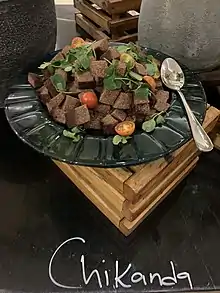Chikanda
Chikanda is a Zambian dish made from the boiled root tubers of terrestrial orchids also called chikanda.[1][2] The dish is often called "African polony" because it has a texture that resembles bologna.[2][3] Chikanda can be eaten as a snack, dessert, or an accompaniment to nshima, a maize flour porridge.[2]
 Chikanda | |
| Alternative names | Kinaka, Chinaka, Kikanda, African Polony, Zambian Polony, Zambian Sausage |
|---|---|
| Type | Snack, Dessert, Side dish |
| Place of origin | |
| Region or state | Southern Africa, East Africa |
| Main ingredients | Orchid tubers, Groundnut meal, Baking soda or ash water, Spices |
Background
Chikanda has been eaten for hundreds of years by people in parts of Zambia, northern Malawi, and southwestern Tanzania.[4] The dish is traditionally associated with the Bemba tribe in northeast Zambia, although it is eaten throughout Zambia today.[2] For the Bemba, it is an integral part of the culture and is served at special occasions such as weddings.[3] Originally a food in the setting of rural scarcity, it has now shifted to an urban trend.[3][4] Now, chikanda can be found being sold by street vendors, supermarkets, and large restaurants as the urban population has an increased demand for this rural tradition.[3]
In Malawi, it is thought that eating the dish will protect against sickness.[5]
In southwestern Tanzania, a similar dish called kinaka in Kiswahili are eaten by the Nyamwanga, Nyika, Nyiha, Fipa, Lungu, and Ndali.[4]
Ingredients
There are many different species of orchids used, but primarily from the Disa, Habenaria, and Satyrium genera.[1][4] Researchers determined that 16 orchid species in 6 genera are in the chikanda trade.[6] The orchid roots resemble the shape of an Irish potato but is smaller in size.[7] The ash water or baking soda with their high pH likely provides supplemental minerals and leads to the soapy taste and firm texture of chikanda.[8]
Preparation
The tubers are dried and pounded.[2] Then, a mixture of the dried brown orchid meal and groundnut meal are boiled to form a slurry.[7] Dried chili peppers can also be added.[2] The slurry is thickened by soda, salted, and flavored with spices.[7] As it simmers, the slurry thickens into a cake and rises like dough.[7] It is usually served sliced.[2]
Sustainability issues
The orchid roots grow wild throughout Zambia.[7] However, due to the high demand, this had led to the present scarcity of the orchids in the country.[1][3] Now, they are illegally imported from Tanzania, Angola, and the Democratic Republic of Congo, leading to the risk of overharvesting abroad.[1][3] Traditional sustainability practices included only harvested tubers that have spread their seed and replanting stalks.[3] However, the locals have abandoned these practices due to increased demand.[3] Unfortunately, the orchids are difficult to cultivate in captivity.[3] Current efforts for conservation focus on cultivating the threatened orchids.[3]
A similar issue with unsustainable harvesting of orchids is noted with the Turkish trade in salep, a starch used in dessert and beverages.[3][4][9]
References
- Joshi, D.D. (2012). Herbal Drugs and Fingerprints: Evidence Based Herbal Drugs. Springer India. p. 9. ISBN 978-81-322-0804-4. Retrieved 2021-10-10.
- "Chikanda - Traditional Snack From Zambia". TasteAtlas. 2017-10-30. Retrieved 2021-10-10.
- "In Zambia, a Craze for a Traditional Treat Is Endangering Wild Orchids". Atlas Obscura. March 2019. Retrieved 2021-10-10.
- Davenport, Tim R. B.; Ndangalasi, Henry J. (2003). "An escalating trade in orchid tubers across Tanzania's Southern Highlands: assessment, dynamics and conservation implications". Oryx. Cambridge University Press (CUP). 37 (1). doi:10.1017/s0030605303000127. ISSN 0030-6053. S2CID 85774089.
- Teoh, E.S. (2019). Orchids as Aphrodisiac, Medicine or Food. Springer International Publishing. p. 305. ISBN 978-3-030-18255-7. Retrieved 2021-10-11.
- Veldman, Sarina; Kim, Seol-Jong; van Andel, Tinde; Bello Font, Maria; Bone, Ruth; Bytebier, Benny; Chuba, David; Gravendeel, Barbara; Martos, Florent; Mpatwa, Geophat; Ngugi, Grace; Vinya, Royd; Wightman, Nicholas; Yokoya, Kazutoma; de Boer, Hugo (2018-11-30). "Trade in Zambian Edible Orchids—DNA Barcoding Reveals the Use of Unexpected Orchid Taxa for Chikanda". Genes. MDPI AG. 9 (12): 595. doi:10.3390/genes9120595. ISSN 2073-4425. PMC 6315803. PMID 30513666.
- Zambia Alliance of Women (1985). Food for Africa: The Promotion of Traditional and Under-utilized Foodstuffs : Report of a Regional Workshop. The Alliance. p. 34. Retrieved 2021-10-10.
- Kaputo, M.T. (1996). "The role of ashes and sodium bicarbonate in a simulated meat product from chikanda tuber (Satyria siva)". Food Chemistry. Elsevier BV. 55 (2): 115–119. doi:10.1016/0308-8146(95)00073-9. ISSN 0308-8146.
- Chase, M.W.; Christenhusz, M.J.M.; Mirenda, T. (2018). The Book of Orchids: A Life-Size Guide to Six Hundred Species from around the World. University of Chicago Press. p. 23. ISBN 978-0-226-22466-4. Retrieved 2021-10-11.